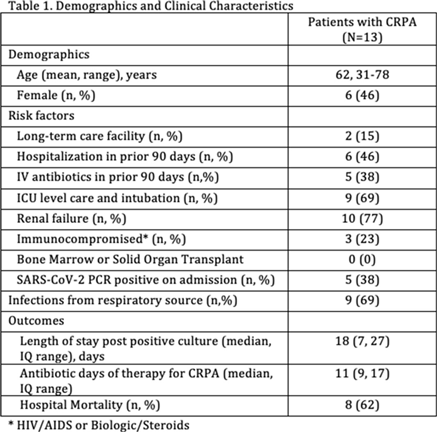No CrossRef data available.
Published online by Cambridge University Press: 29 July 2021
Background: The Centers for Disease Control and Prevention reported 32,600 cases, 2,700 deaths, and healthcare costs of 767 million dollars attributed to multidrug-resistant Pseudomonas aeruginosa. A recent study of 128 patients with nosocomial pneumonia due to P. aeruginosa showed the noninferiority of ceftolozane-tazobactam compared to meropenem. However, the resistance of ceftolozane-tazobactam due to AmpC mutations has been described. Compared with 2019, we observed an increase from 2 to 13 cases of ceftolozane-tazobactam–resistant P. aeruginosa (CRPA) during the COVID-19 pandemic at our institution in the Bronx, New York. Methods: A report of patients with CRPA between March and August 2020 was obtained. Data collected included demographics, hospitalization/IV antibiotic use in prior 90 days, SARS-CoV-2 PCR result, ICU admission, length of stay, antibiotic days of therapy, mortality, etc. Results: In total, 13 patients with CRPA infection were reviewed (Table 1). Among them, 2 patients were on the same inpatient medical-surgical unit but separated by 5 months. Also, 11 patients were from different medical-surgical units or ICUs. In addition, 5 patients (38%) were SARS-CoV-2 PCR positive. None of these COVID-19 patients were cohorted on the same unit, making horizontal spread of CRPA or COVID-19 unlikely. Finally, 8 of these patients died while hospitalized (4 were COVID-19 patients). Conclusions: We found a high incidence of mortality in patients with CRPA infection. Many patients had prolonged hospital stay and required ICU admission. Few patients were from long-term care facilities. Given the associated morbidity and mortality, increased surveillance and intensified antimicrobial stewardship efforts are needed to mitigate the impact of CRPA during the COVID-19 pandemic.
Funding: No
Disclosures: None
Table 1.